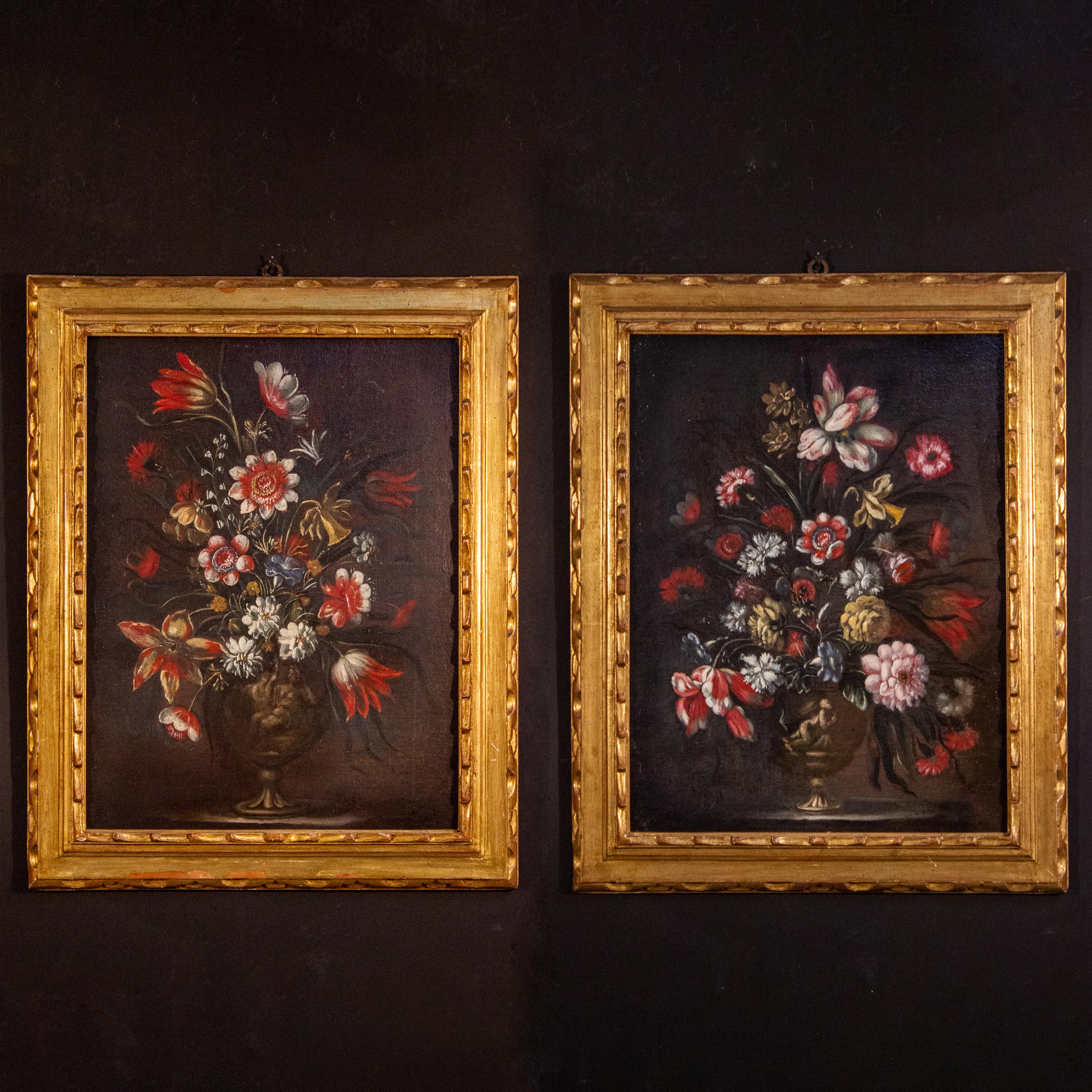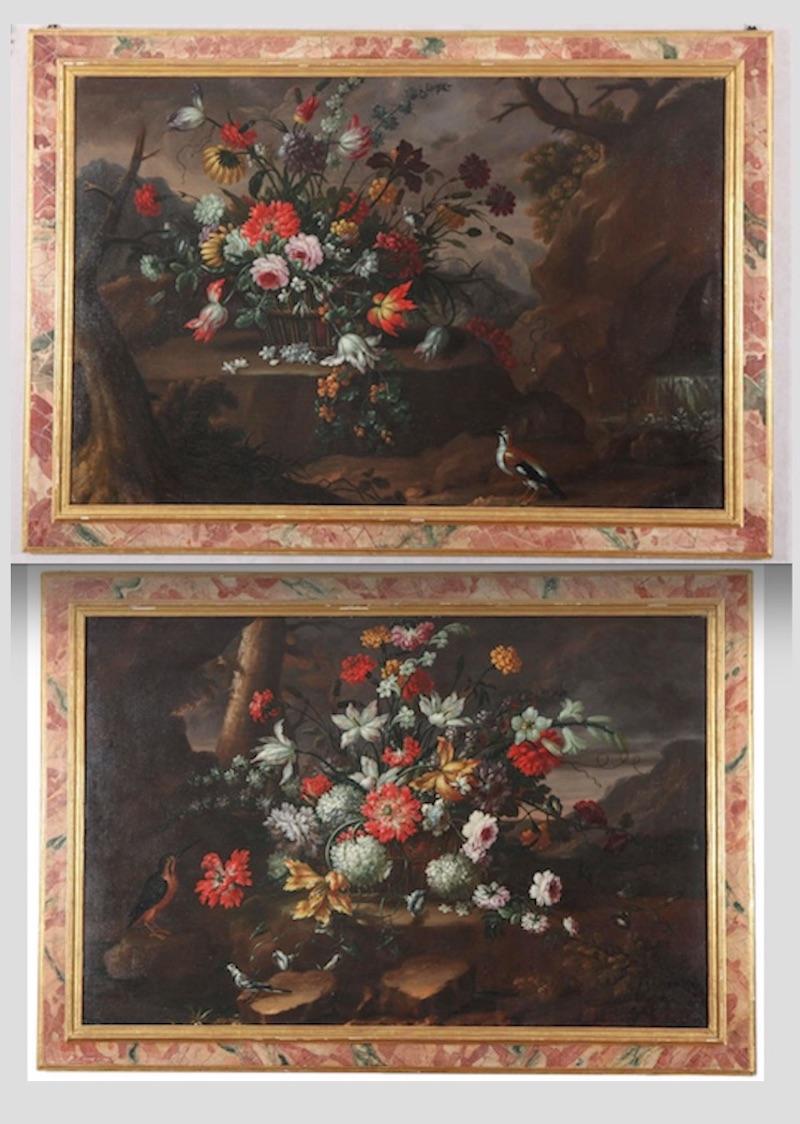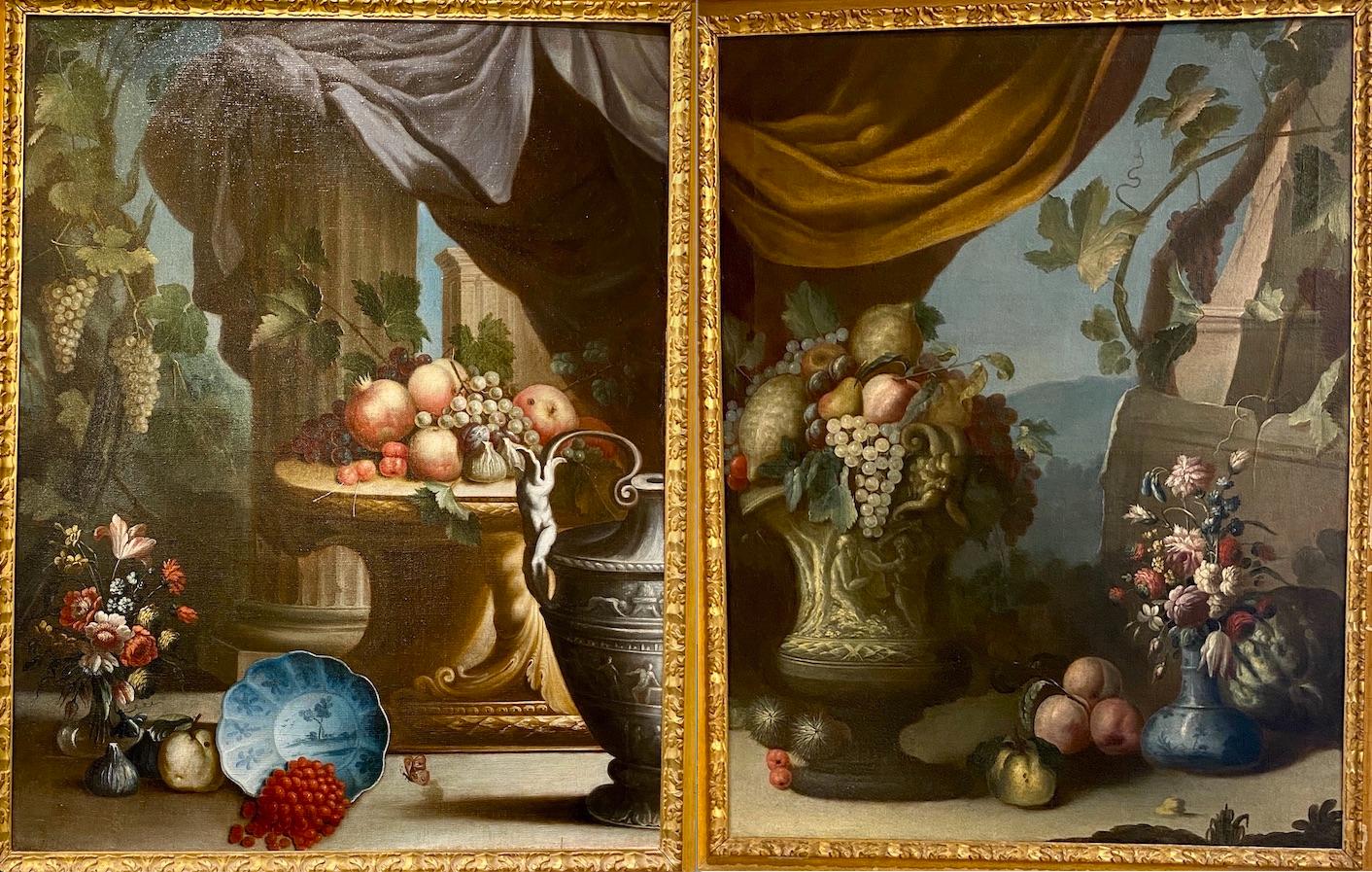Items Similar to Dipinto Natura Morta con Funghi e Fiori XVIII secolo
Want more images or videos?
Request additional images or videos from the seller
1 of 12
UnknownDipinto Natura Morta con Funghi e Fiori XVIII secolo1700s
1700s
About the Item
Olio su tela.
Una delicata composizione di fiori è collocata dentro una sorta di culla di legno, con funghi e frutti per terra; lo sfondo è in esterno, ma poco definito da macchie varie.
L'opera, in prima tela, è presentata peraltro in una bella cornice degli inizi del XVIII secolo, in legno di tiglio intagliata a serto fogliaceo trattenuto da nastri, e dorata a guazzo.
- Creation Year:1700s
- Dimensions:Height: 35.83 in (91 cm)Width: 42.13 in (107 cm)Depth: 2.76 in (7 cm)
- Medium:
- Period:
- Condition:
- Gallery Location:Milan, IT
- Reference Number:1stDibs: LU680314035072
About the Seller
4.8
Gold Seller
These expertly vetted sellers are highly rated and consistently exceed customer expectations.
Established in 2017
1stDibs seller since 2017
101 sales on 1stDibs
Typical response time: 2 hours
- ShippingRetrieving quote...Ships From: Milan, Italy
- Return PolicyA return for this item may be initiated within 14 days of delivery.
More From This SellerView All
- Still Life with Flowers, Fruit and Goldfinch, 17th centuryLocated in Milan, ITOil painting on canvas. In the beautiful composition you can see, resting on an inlaid wooden sideboard, a basket full of cherries, some of which are scattered on the top, and a plat...Category
17th Century Other Art Style Still-life Paintings
MaterialsOil
- Dipinto con Natura morta con Frutta e Vasellame, XX secoloLocated in Milan, ITOlio su tela. La composizione guarda alle produzioni del XVII secolo e propone una tavola riccamente imbandita di vassoi di frutta, cesti di ciliege, canestri con pesche e grappoli d...Category
20th Century Other Art Style Still-life Paintings
MaterialsOil
- Still life, XVII centuryLocated in Milan, ITOil on canvas depicting a still life, a pantry with a table set with a copper basin and different kinds: hanging game, trays full of fruit and cutting boards with fish. On the left o...Category
17th Century Other Art Style Still-life Paintings
MaterialsOil
- Grapes, figs, pomegranate and peaches on a pillar, first quarter 18th centuryBy Maximilian PfeilerLocated in Milan, ITOil on canvas depicting a still life composed of grapes, pomegranate and peaches placed on a pillar, the composition also features a silver tray; in the background a landscape with t...Category
Late 17th Century Other Art Style Still-life Paintings
MaterialsOil
- Still Life with Flowers, Fruit and Pumpkins, XVIIth - XVIIIth centuryLocated in Milan, ITOil painting on canvas. Lombard school of the late 17th-early 18th century. The rich composition offers a large bouquet of colorful flowers in an embossed vase, next to two large pumpkins and mixed fruit (grapes and peaches...Category
Late 17th Century Other Art Style Still-life Paintings
MaterialsOil
- Still Life with Flowers, Grapes and Mushrooms, XVIIth - XVIIIth centuryLocated in Milan, ITOil painting on canvas. Lombard school of the late 17th-early 18th century. The rich composition offers a large bouquet of colorful flowers in an embossed vase, next to a bowl full o...Category
Late 17th Century Other Art Style Still-life Paintings
MaterialsOil
You May Also Like
- Pair of 18th century Italian Still Life Paintings of FlowersLocated in Rome, ITPair of very decorative Italian Still-life paintings of flowers with vases and classical figures . 18th century, oil on canvas, with original gilt-wood frames. This pair is an exce...Category
18th Century Baroque Still-life Paintings
MaterialsOil
- Still Life with Squash, Gourds, Stoneware, and a Basket with Fruit and CheeseLocated in New York, NYProvenance: Selma Herringman, New York, ca. 1955-2013; thence by descent to: Private Collection, New York, 2013-2020 This seventeenth century Spanish still-life of a laden table, known as a bodegón, stands out for its dramatic lighting and for the detailed description of each object. The artist’s confident use of chiaroscuro enables the sliced-open squash in the left foreground to appear as if emerging out of the darkness and projecting towards the viewer. The light source emanates from the upper left, illuminating the array, and its strength is made apparent by the reflections on the pitcher, pot, and the fruit in the basket. Visible brush strokes accentuate the vegetables’ rough surfaces and delicate interiors. Although the painter of this striking work remains unknown, it is a characteristic example of the pioneering Spanish still-lifes of the baroque period, which brought inanimate objects alive on canvas. In our painting, the knife and the large yellow squash boldly protrude off the table. Balancing objects on the edge of a table was a clever way for still-life painters to emphasize the three-dimensionality of the objects depicted, as well a way to lend a sense of drama to an otherwise static image. The knife here teeters on the edge, appearing as if it might fall off the table and out of the painting at any moment. The shape and consistency of the squash at left is brilliantly conveyed through the light brush strokes that define the vegetable’s fleshy and feathery interior. The smaller gourds—gathered together in a pile—are shrouded partly in darkness and stand out for their rugged, bumpy exterior. The stoneware has a brassy glaze, and the earthy tones of the vessels are carefully modulated by their interaction with the light and shadow that falls across them. The artist has cleverly arranged the still-life in a V-shaped composition, with a triangular slice of cheese standing upright, serving as its pinnacle. Independent still-lifes only became an important pictorial genre in the first years of the seventeenth century. In Italy, and particularly through the revolutionary works of Caravaggio, painted objects became carriers of meaning, and their depiction and arrangement the province of serious artistic scrutiny. Caravaggio famously asserted that it was equally difficult to paint a still-life as it was to paint figures, and the elevation of this new art form would have profound consequences to the present day. In Spain Juan Sanchez Cotan...Category
17th Century Old Masters Still-life Paintings
MaterialsCanvas, Oil
- Pair of Exceptional Italian Still Life Paintings of Flowers 18th centuryBy Anna Caterina GilliLocated in Rome, IT- ANNA CATERINA GILLI or GILLI Anna Caterina Turin 1729- 1751 Her paintings recorded in Turin as a decorative artist for the Royal Palace and the Stupinigi, working in a simil...Category
Mid-18th Century Baroque Still-life Paintings
MaterialsOil
- Pair of 18th century Italian Still Life Paintings of FlowersLocated in Rome, ITPair of very decorative Italian Still-life paintings of flowers with vases and classical figures . 18th century, oil on canvas, with original gilt-wood frames. This pair is an exce...Category
18th Century Baroque Still-life Paintings
MaterialsOil
- Pair of Exceptional Italian 18th Century Still-Life PaintingsLocated in Rome, ITThis pair of excellent Italian still life oil on canvas with flowers and fruit with classical ruins on the background and colored drapes create harmony of the composition. Notable ...Category
Early 18th Century Old Masters Still-life Paintings
MaterialsOil
- Thy Name is WomanLocated in Woodbury, CTOil on canvas, signed and dated 2018. French handmade Delf wooden frame, dark bronze patina with gold leaf. Unframed size: 19.7 inches high x 24.02 inches wide. Framed size: 28 inches high x 32.3 inches wide x 1.25 inches deep. Sold framed. Stefaan was gifted this skull by a friend, whose carpenter father found many years ago in a false ceiling. The skull sat in his workshop and was eventually named “Gilda”. The composition is unusual in its stark simplicity that speaks to the inevitable death we all face. Fascinating without being morbid, the arrangement is simple yet bold. Note the extraordinary brushwork detailed in the shroud, as well as the intricacies of the skull. The slash of cobalt blue in the background provides an ethereal quality. The title is adapted from Shakespeare’s Hamlet and is the artist’s inside joke on the character “Guildenstern” vs “Gilda”. Part of the title can be seen in the lower right quadrant of the painting. Compared to “Vanitas”, painted in 2000, the artist’s evolution in form and execution is most evident in this 2018 work. This painting is available for viewing at The Elemental Garden...Category
2010s Realist Still-life Paintings
MaterialsOil





